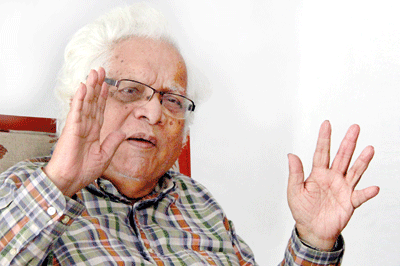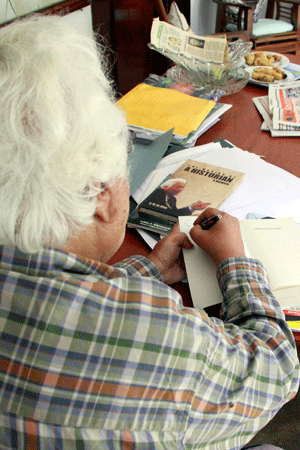A historian looks back

K.M. De Silva: Still writing at 85. Px by Indika Handuwala
“After my first view of Anuradhapura and Polonnaruwa, I came back thinking what a lot these people have done. In the unique architectural styles seen in the Brazen Palace to the moonstone slabs, there is something quite remarkable about the imagination of the people who created them,” said De Silva.
While seeing this living laboratory of the country’s history set in motion his lifelong passion for the subject, there were several of his teachers both at his alma mater Kingwood College, Kandy and the University of Colombo, Peradeniya who helped hone his skill as a historian.
In his recently released memoir aptly named, “The making of a historian”, K.M. De Silva gives a glimpse of his teachers who helped develop his love of history and guided him. Among them were Sydney Perera and Ainsley Samarajiva, two of his teachers in the upper classes at Kingswood, the former a stimulating geography teacher, the latter “who took teaching of history to a much higher level than it had been so far in school.”
Though very satisfied with the essays that K.M. presented in class, early on his teacher Samarajiva had warned against the use of “flowery language and indulging in complex arguments when simple and uncomplicated language along with an easy arrangement of arguments would do just as well or indeed better.” Remarkably, when he entered university, one of his history tutors Father Ignatius Pinto had the same advice for him. In his much acclaimed “A History of Sri Lanka” first published in 1981, K.M. De Silva has stuck to this advice using simple language to tell the complex history of Sri Lanka. This maybe one reason for the book’s popularity as it remains one of the most read books on the country’s history more than three and half decades after it was first published.
“It took me six to seven years to complete the book. Every day I would write from around 5 a.m. to 7 a.m. and get on with the other work for the day. Then once again I would return to writing from around four in the evening and continue till about 11 p.m,” he said. The book was snatched up by the first publisher he sent the manuscript to and since then thousands of copies have been sold all over the world and also used in schools to teach Sri Lanka’s history.
De Silva graduated with a first class in history in 1955 but unlike the majority of his contemporaries, he turned his back on a chance to join the much coveted Ceylon Civil Service instead choosing to become a teacher of history. “For newly passed out graduates of the day, the next rite of passage was to involve themselves in what was called the “civil war”, a struggle for a place in the CCS.” He decided against it and instead aimed at gaining a teaching position in the Department of History at his university.
He entered as an assistant lecturer, no mean task given that there were very few openings and the chances of appointment to the post was determined by one’s performance in the final examination as well as the capacity to evolve as a good teacher, researcher and writer. He secured the post the following year, in 1956 going onto become a Professor of History in 1969, a post which he continued in till his retirement in 1995.
From historian, K.M. De Silva also became a biographer writing a two-volume biography of Sri Lanka’s first Executive President J.R. Jayewardene. The book titled “ J.R. Jayewardene of Sri Lanka”, which he co-authored with Howard Wriggins also took another six to seven years to complete.
Being a biographer meant spending many hours in the company of President Jayewardene, one of the most controversial figures in the country’s post-independence political scene. However, despite the friendship the two shared, he did not let it cloud his objectivity when writing the biography.
“He (JRJ) was a much friendlier and a much more humane person than many of you think. I was his biographer and I must say in fairness to him that while some people would exploit the situation and get the biographer to say something positive about them, JRJ never did that,” he said.

Autographing Volume One of his memoirs:More stories to tell
At the age of 85, K.M. De Silva who was appointed as the Chancellor of the University of Peradeniya in May this year is nowhere near hanging up his writing boots. Writing in long hand, he spends a considerable time each day putting pen to paper finalizing Volume Two of his memoir in which among others he will discuss in detail his experiences of writing the biography of JRJ. A short biography of the country’s first Prime Minister D.S.Senanayake too is due to be released later this year.
Even writing a short biography on D.S. Senanayake has meant doing a lot of research including reading a large number of dispatches and summarizing them, particularly documents related to the time when the grand old man of Sri Lankan politics negotiated the country’s independence from the British.
In this regard, K.M. De Silva says, D.S. Senanayake did a great deal better than his contemporaries in South Asia.
“When you look at the period when we were negotiating for our independence, he (D.S) did far better than (Jawaharlal) Nehru or (Mohammed Ali) Jinnah. They died leaving behind huge problems whereas when D.S. died, he left no serious problems behind. Everybody had contempt for him (D.S) saying he was not educated but he left the educated people standing,” he said.
He has chosen to keep his future writings concise having come to the conclusion that “in this country people don’t read enough”. “The trick is to make things more readable and get them interested in the country’s history. It is important for people to know how they have evolved,” he says.
Also in the pipeline are short biographies on two former Prime Ministers S.W.R.D. Bandaranaike and Mrs.Sirimavo Bandaranaike and one on the first Vice Chancellor of the University of Ceylon Ivor Jennings.
Outside his academic world, K.M. De Silva has another love, cricket. He recollects with great fondness the scrapbook that he put together as a schoolboy using newspaper cuttings from British papers that were used to wrap things in. It was entirely on the infamous “bodyline’ bowling tactics used by the England team against the Australians during the Ashes tour in 1932-33.
“I used to collect all these papers and one day my mother told me if I didn’t clear it up soon she’d burn all of them so I decided to put together this scrapbook entirely on the “bodyline” series. Unfortunately, someone borrowed the book and I never saw it again.”
As Sri Lanka prepares to celebrate its 70th anniversary of independence next year, K.M. De Silva is optimistic about the country’s future. “I am more optimistic than most others. Ours is a small country and for a small country we have done a great deal,” he added.


